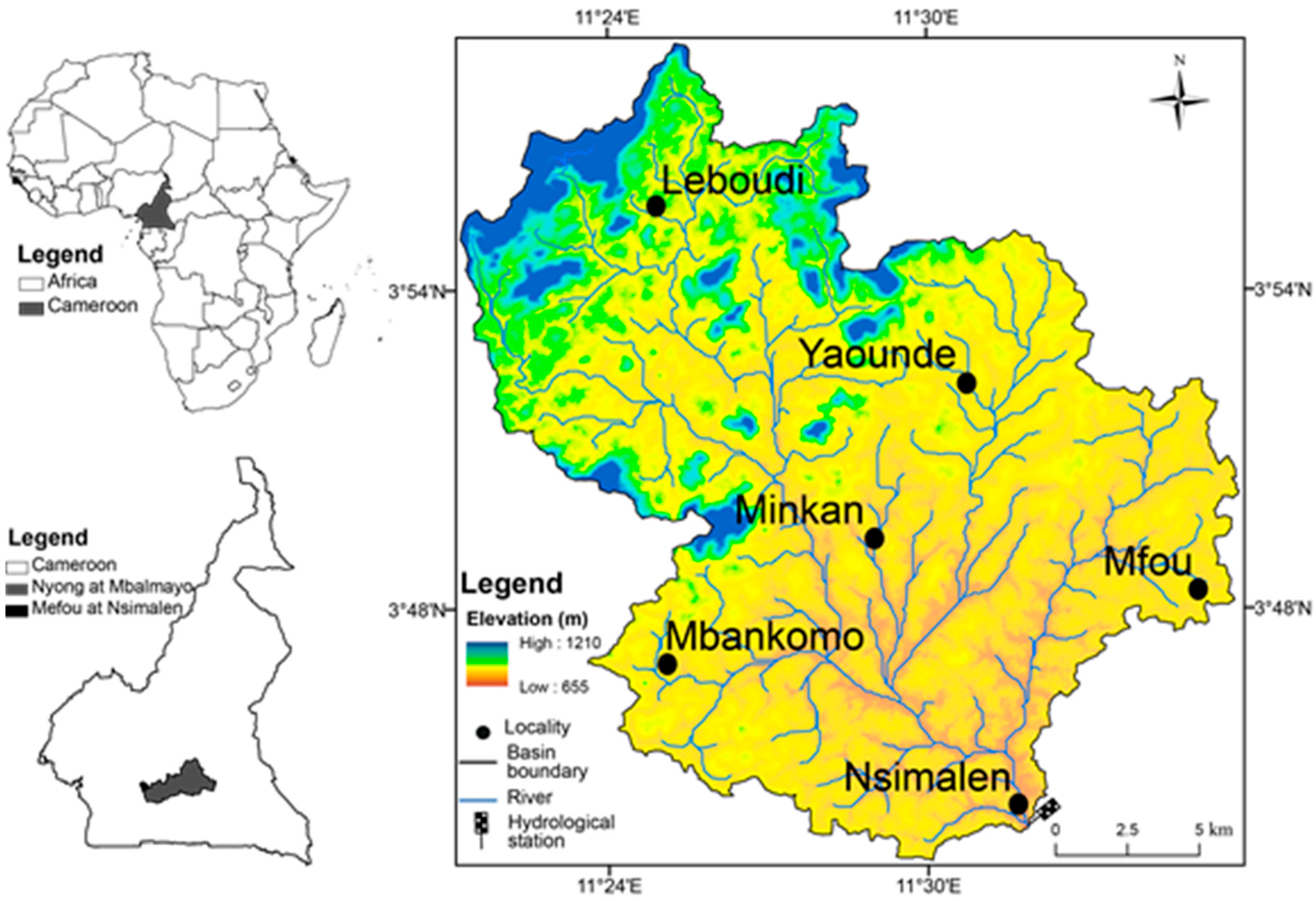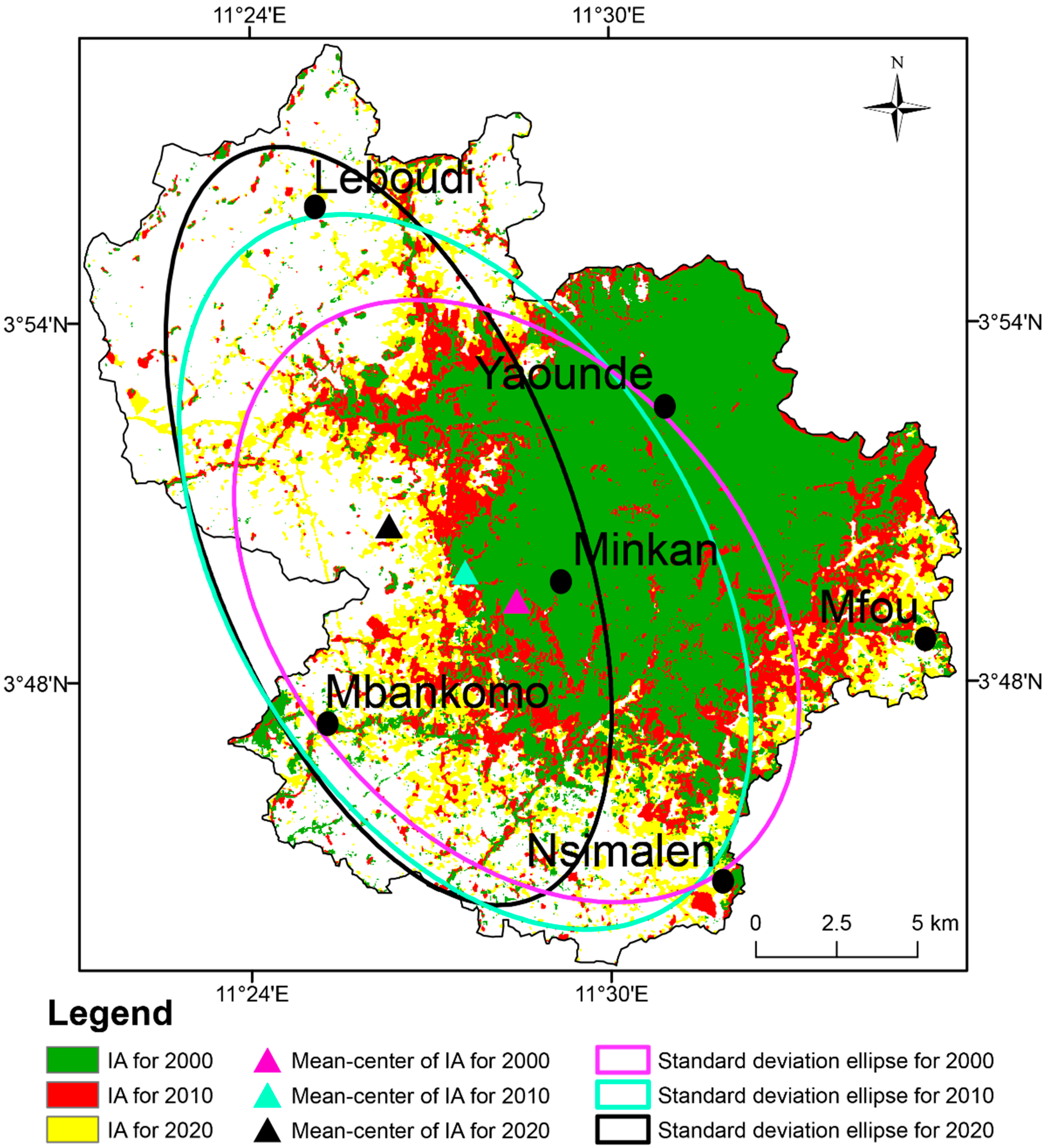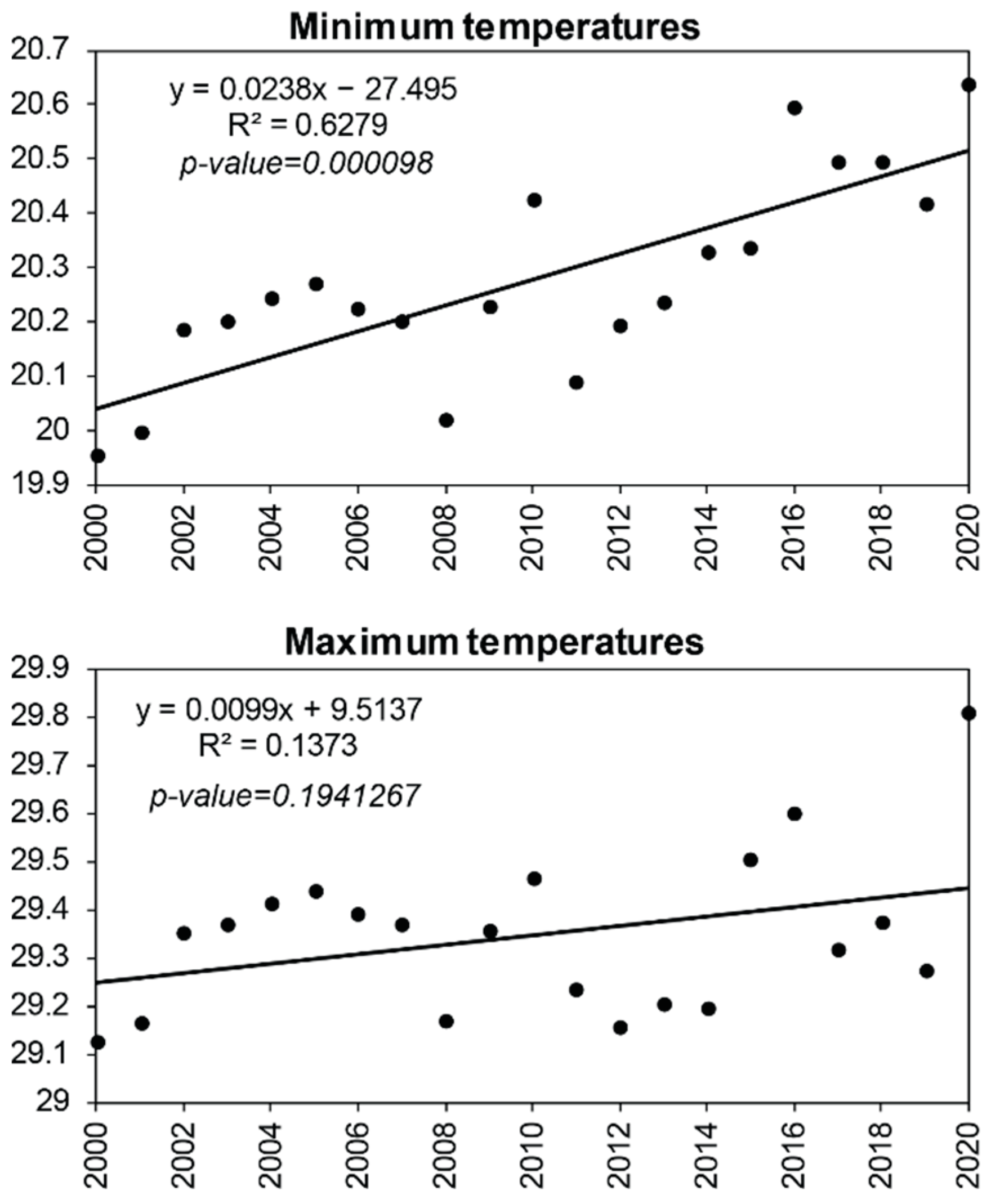Land Surface Temperature Variation in Response to Land Use Modes Changes: The Case of Mefou River Sub-Basin (Southern Cameroon)
Abstract
:1. Introduction
2. Materials and Methods
2.1. Study Area
2.2. Data Sources
2.3. Land Use/Land Cover Classification
2.4. LST Retrieval
2.4.1. Step I: Conversion of the Digital Number (DN) into Spectral Radiance (L)
2.4.2. Step II: Conversion to Brightness Temperature
2.4.3. Step III: Land Surface Emissivity Estimation
2.5. Analysis of Annual Maximum and Minimum Air Temperatures
3. Results and Discussion
3.1. Changes in Land Use Modes
3.2. Normalized Difference Vegetation Index (NDVI) Analysis
3.3. LST Variation in Response to LUM Dynamics
3.4. LST Validation Results with Respect to Air Temperature
4. Conclusions
Funding
Institutional Review Board Statement
Informed Consent Statement
Data Availability Statement
Conflicts of Interest
References
- Abebe, M.S.; Derebew, K.T.; Gemeda, D.O. Exploiting temporal-spatial patterns of informal settlements using GIS and remote sensing technique: A case study of Jimma city, Southwestern Ethiopia. Environ. Syst. Res. 2019, 8, 6. [Google Scholar] [CrossRef] [Green Version]
- Negassa, M.D.; Mallie, D.T.; Gemeda, D.O. Forest covers change detection using Geographic Information Systems and remote sensing techniques: A spatio temporal study on Komto Protected Forest priority area, East Wollega Zone Ethiopia. Environ. Syst. Res. 2020, 9, 1. [Google Scholar] [CrossRef] [Green Version]
- Negash, D.A.; Moisa, M.B.; Merga, B.B.; Sedeta, F.; Gemeda, D.O. Soil erosion risk assessment for prioritization of sub-watershed: The case of Chogo Watershed, Horo Guduru Wollega, Ethiopia. Environ. Earth. Sci. 2021, 80, 589. [Google Scholar] [CrossRef]
- Feng, Y.; Li, H.; Tong, X.; Chen, L.; Liu, Y. Projections of land surface temperature considering the effects of future land change in the Taihu Lake Basin of China. Glob. Planet Change 2018, 167, 24–34. [Google Scholar] [CrossRef]
- Das, N.; Mondal, P.; Sutradhar, S.; Ghosh, R. Assessment of variation of land use /land cover and its impact on land surface temperature of Asansol subdivision. Egypt J. Remote Sens. Space Sci. 2020, 24, 131–149. [Google Scholar] [CrossRef]
- Deng, X.Z.; Huang, J.K.; Han, J.Z.; Rozelle, S.; Zhang, J.P.; Li, Z.H. Impact of urbanization on cultivated land changes in China. Land Use Policy 2015, 45, 1–7. [Google Scholar] [CrossRef]
- Wang, L.; Tian, F.; Wang, X.; Yang, Y.; Wei, Z. Attribution of the land surface temperature response to land-use conversions from bare land. Glob. Planet. Change 2020, 193, 103268. [Google Scholar] [CrossRef]
- Gemeda, D.O.; Korecha, D.; Garedew, W. Evidences of climate change presences in the wettest parts of Southwest Ethiopia. Heliyon 2020, 7, e08009. [Google Scholar] [CrossRef]
- Kiswanto, T.S.; Mardiany, S. Completing yearly land cover maps for accurately describing annual changes of tropical landscapes. Glob. Ecol. Conserv. 2018, 13, e00384. [Google Scholar] [CrossRef]
- Kayet, N.; Pathak, K.; Chakrabarty, A.; Sahoo, S. Spatial impact of land use/land cover change on surface temperature distribution in Saranda Forest, Jharkhand. Modell. Earth Syst. Environ. 2016, 2, 127. [Google Scholar] [CrossRef]
- Aires, F.; Prigent, C.; Rossow, W.B.; Rothstein, M. A new neural network approach including first guess for retrieval of atmospheric water vapor, cloud liquid water path, surface temperature, and emissivity over land from satellite microwave observations. J. Geophys. Res. 2001, 106, 14887–14907. [Google Scholar] [CrossRef]
- James, M.M.; Mundia, C.N. Dynamism of land use changes on surface temperature in Kenya: A case study of Nairobi City. Int. J. Sci. Res. 2014, 3, 38–41. [Google Scholar]
- Gemes, O.; Tobak, Z.; Van Leeuwen, B. Satellite based analysis of surface Urban Heat Intensity. J. Environ. Geogr. 2016, 9, 23–30. [Google Scholar] [CrossRef] [Green Version]
- Okinyemi, F.O.; Ikanyeng, M.; Muro, J. Land cover change effects on land surface temperature trends in an African Urbanizing dryland region. City Environ. Interact. 2019, 4, 100029. [Google Scholar] [CrossRef]
- Dissanayake, D.; Morimoto, T.; Murayama, Y.; Ranagalag, M. Impact of landscape structure on the variation of Land Surface Temperature in Sub-Saharan Region. A case Study of Addis Ababa using Landsat Data (1986–2016). Sustainability 2019, 11, 2257. [Google Scholar] [CrossRef] [Green Version]
- Tafesse, B.; Suryabhagavan, K.V. Systematic modelling of impacts of land-use and land-cover changes on land surface temperature in Adama Zuria District, Ethiopia. Model. Earth Syst. Environ. 2019, 5, 805–817. [Google Scholar] [CrossRef]
- Letouzey, R. Notice de la Carte Phytogéographique du Cameroun au 1/500,000; Institut de la Carte Internationale de la Végétation: Toulouse, France, 1985. [Google Scholar]
- Nkiaka, E.; Nawaz, R.; Lovett, J.C. Assessing the reliability and uncertainties of projected changes in precipitation and temperature in Coupled Model Intercomparison Project phase 5 models over the Lake Chad basin. Int. J. Climatol. 2018, 38, 5136–5152. [Google Scholar] [CrossRef] [Green Version]
- Ebodé, V.B.; Mahé, G.; Dzana, J.G.; Amougou, J.A. Anthropization and Climate Change: Impact on the Discharges of Forest Watersheds in Central Africa. Water 2020, 12, 2718. [Google Scholar] [CrossRef]
- Ebodé, V.B.; Dzana, J.G.; Nkiaka, E.; Nka, N.B.; Braun, J.J.; Riotte, J. Effects of climate and anthropogenic changes on current and future variability in flows in the So’o River Basin (South of Cameroon). Hydrol. Res. 2022, 53, 1203–1220. [Google Scholar] [CrossRef]
- Hamstead, Z.A.; Kremer, P.; Larondelle, N.; McPhearson, T.; Haase, D. Classification of the heterogenous structure of urban landscapes (STURLA) as an indicator of landscape functions applied to surface temperature in New York City. Ecol. Indic. 2015, 70 (Suppl. C), 574–585. [Google Scholar] [CrossRef]
- Chibuike, E.M.; Ibukun, A.O.; Kunda, J.J.; Abbas, A. Assessment of green parks cooling effects on Abuja urban microclimate using geospatial techniques. Remote Sens. Appl. 2018, 11, 11–21. [Google Scholar] [CrossRef]
- Chander, G.; Markham, B. Revised landsat-5 TM radiometrie calibration procedures and post-calibration dynamic ranges. IEEE Trans Geosci Remote Sens. 2003, 41, 2674–2677. [Google Scholar] [CrossRef] [Green Version]
- Carlson, T.N.; Riziley, D.A. On the relation between NDVI, fractional vegetation cover, and leaf area index. Remote Sens. Environ. 1997, 62, 241–252. [Google Scholar] [CrossRef]
- Ewane, E.B.; Lee, H.H. Assessing land use/land cover change impacts on the hydrology of Nyong River Basin, Cameroon. J. Mt. Sci. 2020, 17, 50–67. [Google Scholar] [CrossRef]
- Ebodé, V.B.; Mahé, G.; Amoussou, E. Impact de la variabilité climatique et de l’anthropisation sur les écoulements de la Bénoué (nord Cameroun). Proc. IAHS 2021, 384, 261–267. [Google Scholar] [CrossRef]
- Ebodé, V.B.; Braun, J.J.; Nnomo, B.N.; Mahé, G.; Nkiaka, E.; Riotte, J. Impact of Rainfall Variability and Land Use Change on River Discharge in South Cameroon. Water 2022, 14, 941. [Google Scholar] [CrossRef]
- Ebodé, V.B. Impact of rainfall variability and land-use changes on river discharge in Sanaga catchment (forest–savannah transition zone in Central Africa). Hydrol. Res. 2022, 53, 1017–1030. [Google Scholar] [CrossRef]
- Leblanc, M.; Favreau, G.; Massuel, S.; Tweed, S.; Loireau, M.; Cappelaere, B. Land clearance and hydrological change in the Sahel: South-west Niger. Glob. Planet Change 2008, 61, 49–62. [Google Scholar] [CrossRef]
- Amogu, O.; Descroix, L.; Yéro, K.S.; Le Breton, E.; Mamadou, I.; Ali, A.; Vischel, T.; Bader, J.-C.; Moussa, I.B.; Gautier, E.; et al. Increasing river flows in Sahel? Water 2010, 2, 170–199. [Google Scholar] [CrossRef] [Green Version]
- Gebrelibanos, T.; Assen, M. Land use/land cover dynamics and their driving forces in the Hirmi watershed and its adjacent agro-ecosystem, highlands of Northern Ethiopia. J. Land Use Sci. 2015, 10, 81–94. [Google Scholar] [CrossRef]
- Belay, T.; Mengistu, D.A. Land use and land cover dynamics and drivers in the Muga watershed, Upper Blue Nile basin, Ethiopia. Remote Sens. Appl. Soc. Environ. 2019, 15, 100249. [Google Scholar] [CrossRef]
- Yang, J.; Sun, J.; Ge, Q.; Li, X. Assessing the impacts of urbanization—Associated green space on urban land surface temperature: A case study of Dalian, China. Urban For. Urban Green. 2017, 22, 1–10. [Google Scholar] [CrossRef]
- Weng, Q.; Lu, D.; Schubring, J. Estimation of land surface temperature- vegetation abundance relationship for urban heat island studies. Remote Sens. Environ. 2004, 89, 467–483. [Google Scholar] [CrossRef]
- Zhou, W.; Huang, G.; Cadenasso, M.L. Does spatial configuration matter? Understanding the effects of land cover pattern on land surface temperature in urban landscapes. Landsc. Urban Plan 2011, 102, 54–63. [Google Scholar] [CrossRef]
- Worku, G. Modeling land surface temperature from satellite data, the case of Addis Ababa. In Proceedings of the ES RI, Eastern Africa Education GIS Conference, Africa Hall, United Nations Conference Centre, Addis Ababa, Ethiopia, 23–24 September 2016. [Google Scholar]
- Workaye, S.; Suryabhagavan, K.V.; Belliethathan, S. Urban green areas to mitigate urban heat island effect: The case of Addis Ababa, Ethiopia. Int. J. Ecol. Environ. Sci. 2018, 44, 353–367. [Google Scholar]







| Images | Path | Row | Pixel Size | Acquisition Date | Sources |
|---|---|---|---|---|---|
| Landsat ETM+ of 2000 | 185 | 57 | 30 × 30 | January 2000 | U.S. Geological Survey |
| Landsat ETM + of 2010 | 185 | 57 | 30 × 30 | December 2010 | U.S. Geological Survey |
| Landsat OLI/TIRS of 2020 | 185 | 57 | 30 × 30 | January 2020 | U.S. Geological Survey |
| Constant 1-K1 Watts/(m2∗ster∗μm) | Constant 2-K2 Kelvin | |
|---|---|---|
| Landsat 7 | 666.09 | 1282.71 |
| Landsat 8 | 774.8853 | 1321.0789 |
| Land Use Modes | Area Occupied in the Basin (km2) | 2000–2010 | 2010–2020 | 2000–2020 | |||||
|---|---|---|---|---|---|---|---|---|---|
| 2000 | 2010 | 2020 | km2 | % | km2 | % | km2 | % | |
| Built and roads | 118.1 | 127.1 | 130 | 9.0 | 7.6 | 2.9 | 2.3 | 11.9 | 10 |
| Forest | 273.3 | 228.1 | 188 | −45.2 | −16.5 | −40.1 | −17.6 | −85.3 | −31.2 |
| Water | 0.8 | 0.8 | 0.7 | 0.0 | −2.4 | −0.1 | −12.5 | −0.1 | −14.6 |
| Bare soils and farm lands | 35.7 | 72.1 | 109 | 36.3 | 101.8 | 36.8 | 51.1 | 73.2 | 204.9 |
| LST Year | Area | % of LST Class Observed in Each LUM (%) | |||||
|---|---|---|---|---|---|---|---|
| LST Classes | km2 | % | Built and Roads | Forest | Water | Bare Soils and Farm Lands | |
| 2000 | 17–22 | 96.6 | 22.6 | 5.1 | 94 | 0.5 | 0.4 |
| 23–24 | 161.0 | 37.6 | 12.8 | 83.9 | 0.2 | 3.1 | |
| 25–25 | 94.2 | 22.0 | 41.7 | 44.3 | 0 | 14 | |
| 26–27 | 55.7 | 13.0 | 73.2 | 11.1 | 0 | 15.6 | |
| 28–34 | 20.6 | 4.8 | 81.6 | 3.9 | 0 | 14.6 | |
| 2010 | 18–21 | 67.8 | 15.8 | 6.5 | 91.7 | 0 | 1.8 |
| 23–24 | 152.6 | 35.7 | 7.5 | 83.1 | 0.2 | 9.2 | |
| 24–24 | 93.5 | 21.8 | 25.2 | 41.8 | 0 | 32.9 | |
| 25–26 | 69.9 | 16.3 | 64.9 | 6.9 | 0 | 28.2 | |
| 27–49 | 44.1 | 10.3 | 87.5 | 0.9 | 0 | 11.6 | |
| 2020 | 45–47 | 76.6 | 17.9 | 0 | 98.7 | 0.9 | 0.4 |
| 48–48 | 99.2 | 23.2 | 1.3 | 86.7 | 0 | 12 | |
| 49–49 | 94.2 | 22.0 | 17.8 | 27.3 | 0 | 54.9 | |
| 50–50 | 101.1 | 23.6 | 61.3 | 1.6 | 0 | 37.1 | |
| 51–55 | 56.9 | 13.3 | 88.4 | 0 | 0 | 11.6 | |
Disclaimer/Publisher’s Note: The statements, opinions and data contained in all publications are solely those of the individual author(s) and contributor(s) and not of MDPI and/or the editor(s). MDPI and/or the editor(s) disclaim responsibility for any injury to people or property resulting from any ideas, methods, instructions or products referred to in the content. |
© 2023 by the author. Licensee MDPI, Basel, Switzerland. This article is an open access article distributed under the terms and conditions of the Creative Commons Attribution (CC BY) license (https://creativecommons.org/licenses/by/4.0/).
Share and Cite
Ebodé, V.B. Land Surface Temperature Variation in Response to Land Use Modes Changes: The Case of Mefou River Sub-Basin (Southern Cameroon). Sustainability 2023, 15, 864. https://doi.org/10.3390/su15010864
Ebodé VB. Land Surface Temperature Variation in Response to Land Use Modes Changes: The Case of Mefou River Sub-Basin (Southern Cameroon). Sustainability. 2023; 15(1):864. https://doi.org/10.3390/su15010864
Chicago/Turabian StyleEbodé, Valentin Brice. 2023. "Land Surface Temperature Variation in Response to Land Use Modes Changes: The Case of Mefou River Sub-Basin (Southern Cameroon)" Sustainability 15, no. 1: 864. https://doi.org/10.3390/su15010864







